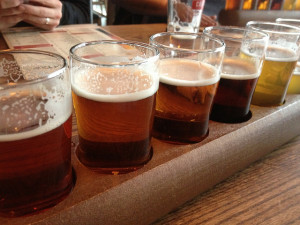The best way to start this process is by talking to people who are in a similar position. You need to find and connect with your peers.
Those peers can be in your exact same business or category, or they can be other people operating in your target market. There’s something so valuable about being able to sit down and talk with people who are on the same path as you. It allows for collaboration and support, shared experiences and expanded business relationships.
I’m very fortunate to live in an area with a lot of entrepreneurs. As a result, there’s an ecosystem of cool startups and products, including an entire local industry built on craft-brewed beer. As you might imagine, the topic of product and service pricing comes up a lot. Having other entrepreneurs to talk with can take a lot of the guesswork out of the process.
As a business coach, I’ve been able to work with perhaps a dozen local startups who have gone through that pricing process, and every one of them has been a little bit different than the others. At the same time, they’ve all been going through the same kinds of struggles and debates, and they all have experiences with how their pricing strategies were received by the market. That collective wealth of information is incredible, if you can tap into it.
Don’t sweat the competition. I know what you’re thinking: Won’t those people see me as competition? Why should they help me? Don’t I run the risk of them giving me bad advice, or using my ideas for their own advantage?
It’s true that talking with a direct competitor isn’t always the best idea, particularly if you have seemingly identical products. But within a product or service category, people are generally more supportive than competitive. If you’re selling dehydrated carrot chips, you might technically be competing with someone who makes organic granola bars in the “healthy snacks” category. You’re in a similar business, and theoretically in competition, but few people would really see it that way in practice.
A great example is the huge amount of small craft breweries we have in my hometown of Asheville, NC. There are 20 small breweries within the city limits, and almost as many more within a 45-minute drive. In theory, they are all in competition with each other in some way, from grocery store shelf space to beer-tourism dollars.
To make matters even more complex, a few mid-sized craft breweries like Oskar Blues, New Belgium and Sierra Nevada have relocated or expanded to the area. These are breweries that produce millions of bottles of beer every year. You might think that the local brewers would be hostile to these new players elbowing into their turf, and making it even tougher to compete.
There was some of that attitude early on, but on the whole, the local brewing community was incredibly supportive. It’s easy to see why, if you think about it for a moment. Having these big regional brewers in the area meant having access to more knowledge and resources.
That’s exactly how these bigger breweries positioned themselves when they came to town, and it worked. A national brand like Sierra Nevada isn’t really competing with a tiny brewery like Green Man Brewing. If anything, these local brewers have more to gain by working together, sharing resources and building relationships as their collective reach expands.
This isn’t just true for brewers. Most people in most industries and categories would rather have friendly rivalries than cutthroat competitors. In some categories, there may even be trade groups you can connect with, making the process of meeting people and sharing knowledge that much easier.
What does all this have to do with pricing? All of this collaboration and sharing have allowed the local brewers to thrive, generating profit from the tap at a local brew pub to a six-pack at the gas-station cooler on the edge of town. The local brewers have their pricing down to a science, and instead of resulting in brutal competition for every dollar, it has actually generating a booming business environment. Asheville beers are now becoming regional products, and shared pricing and market knowledge among peers is a big part of that success.
In part two of this series, I’ll be exploring the next major stage in determining product price: Cost. Knowing the true costs behind your product, including the ones you might be overlooking, is a key part of generating a strong profit.

